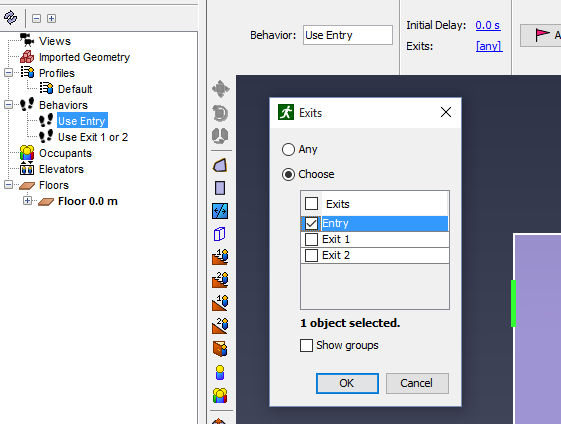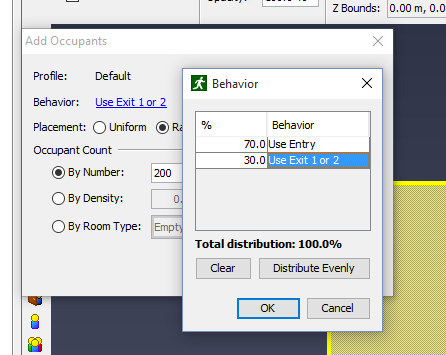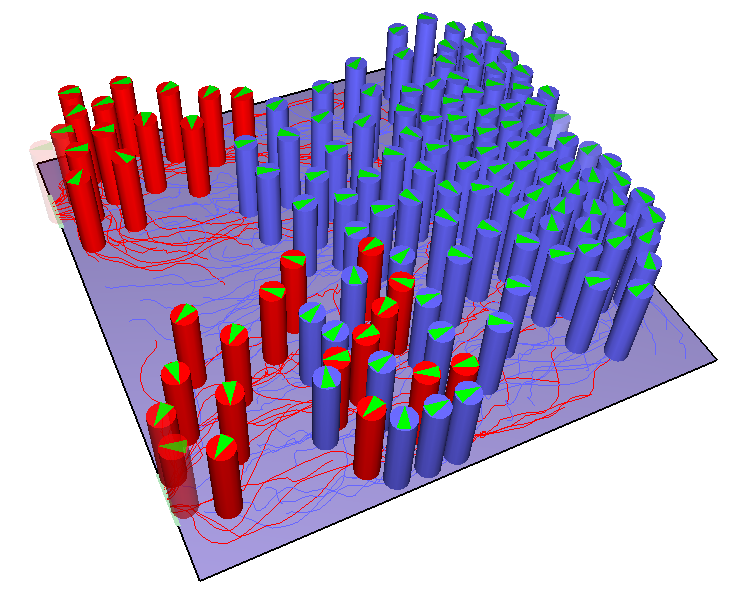To follow along with this tutorial, download the assign-familiar-exit-doors.pth model here.
Introduction
During an evacuation, "… familiar entry routes are more likely to be used for evacuation than egress routes that have never been experienced before. Consequently, routes that are being counted on to "drain" the building of its occupants may be disregarded in an actual evacuation." (SFPE 2016). One way to represent this is to assign some fraction of occupants to use an exit door (or doors) with which they are familiar, while other occupants can use any exit. We will demonstrate this technique with a simple example.
Familiar Paths Example
In Figure 1 we show a room that has one familiar Entry and two Exits. The room is 10×10 m and we will place 200 occupants in the room. We want 70% of the occupants to evacuate using the Entry and 30% using either of the two Exits.

To do this, we define two Behaviors. For the first, we edit the Exits and choose only the Entry door. For the second, we edit the Exits and choose both Exit 1 and Exit 2.

Now we right-click on the room and select Add Occupants. In the Add Occupants dialog, we click on the Behavior and assign 70% to Use Entry and 30% to Use Exit 1 or 2. This can be seen in Figure 3.

Finally, we assign a different color to the occupants using the exits by right-clicking on the Use Exit 1 or 2 behavior and clicking Select Referencing Objects. We change the color of those occupants to red.
When we view the results (Figure 4), we see that the blue occupants (140 persons) exit using the familiar entry and the red occupants (60 persons) use either of the two exits.

To download the most recent version of Pathfinder, please visit the Pathfinder Support page and click the link for the current release. If you have any questions, please contact support@thunderheadeng.com
Bibliography
SFPE. 2016. SFPE Handbook of Fire Protection Engineering. 5th ed. Springer-Verlag New York. https://www.springer.com/us/book/9781493925643.
Related Tutorials
Video tutorial demonstarting how to assign exit goals to percentages of the occupant population.
Video tutorial demonstrating how to effectively simulate evacuation of theaters and stadiums using Pathfinder.
Tutorial to experience the fundamental features of Pathfinder with a mixed purpose multi-floor building
Tutorial demonstrating how to model passenger movement in a large subway station.
Tutorial demonstrating how to model Occupants that respsond to Triggers to shop.
Tutorial demonstrating how to model occupants that respond to Triggers to evacuate in a small conceptual model.
Video tutorial demonstrating the variables that may have an effect on evacuation time from aircraft cabins.
This tutorial teaches the user how to create circulation movement using Queues in an example cafeteria model.
